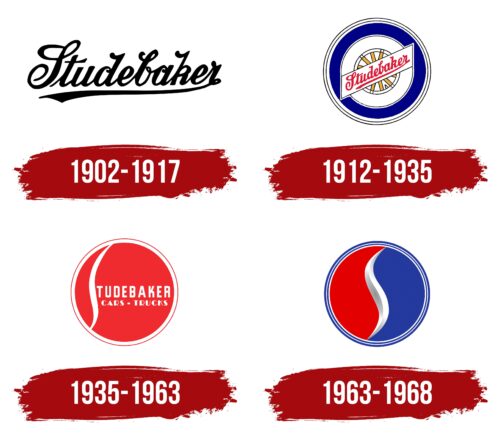The Studebaker logo showcases the brand’s evolution from a blacksmith shop producing carriages to an automobile manufacturing plant. The emblem, used at various times, reflects the family company’s concept and marketing, conveying its values and motivation for growth.
Studebaker: Brand overview
In 1852, brothers Henry and Clement Studebaker established a blacksmith shop in South Bend, Indiana, marking the beginning of the company’s history. The initial focus was on producing wagons and carriages. Their firm grew swiftly due to their products’ quick reputation for quality and dependability.
Their younger brother John joined them in 1858, contributing to increased output. The Union Army awarded sizable contracts to build wagons and carriages during the American Civil War (1861–1865), greatly bolstering the company’s financial situation.
Following the war, the business grew and eventually became the biggest producer of horse-drawn cars worldwide. In 1868, it was formally established as the Studebaker Brothers Manufacturing Company.
When cars became popular in the late 19th century, the company started adjusting to the new way of getting around. The first electric vehicle debuted in 1902, and in 1904, it unveiled its first gasoline-powered vehicle.
1911 proved to be a crucial year. The company concentrated solely on making cars and completely stopped producing horse-drawn carriages. Their first entirely proprietary car, the Studebaker-Garford Model 35, was unveiled in the same year.
The 1920s were a time of expansion and wealth for the company. Several popular models were introduced, such as the Big Six and Special Six. In 1926, one of the first automakers to establish a vehicle testing proving site was created.
The company was severely impacted by the Great Depression of the 1930s. It almost went bankrupt, but it rebounded by restructuring and introducing new models, like the opulent President and the well-liked Dictator.
Like many other automakers, the business focused on building military vehicles during World War II. Trucks were produced, notably the well-known US6, which the Soviet Union received as part of the Lend-Lease initiative.
The company resumed manufacturing civilian automobiles following the war. In 1947, they debuted the ground-breaking Studebaker Champion, which had an avant-garde sleek design and impacted the whole car industry.
The company had a strong start to the 1950s. Popular models included the Commander and Land Cruiser. The Studebaker Starliner, which debuted in 1953 and is regarded as one of the most exquisite automobiles ever made, was another popular model.
But by the end of the 1950s, the company was having financial problems. It struggled to compete with the “Big Three” (Ford, Chrysler, and General Motors) regarding marketing spending and production volume.
Although Studebaker and Packard combined to establish the Studebaker-Packard Corporation in 1954, their financial issues persisted. Packard vehicle production ended in 1958.
The 1960s were the final decade as a manufacturer. Compact models like the Lark and the sporty Avanti were produced to keep the company afloat, but financial difficulties persisted.
After the company liquidated its South Bend headquarters in 1963, all production was transferred to Hamilton, Ontario, Canada. However, this action was insufficient to salvage the business, and the last Studebaker vehicle left the assembly line on March 17, 1966, ending the company’s 114-year existence in the automobile sector.
Following the end of automobile manufacturing, the corporation continued as a multifaceted entity, working on several non-automotive projects. In 1967, the business changed its name to Studebaker-Worthington Inc.
Several of the former company’s components were sold or reformed in the following years. The Studebaker name endures mostly among classic automobile collectors and enthusiasts who maintain and restore vehicles bearing this illustrious nameplate.
Meaning and History
What is Studebaker?
Known for its reliable designs and ongoing contributions to the automotive industry, the company was a legendary American automaker. Founded initially as a manufacturer of wagons and carriages, the company seamlessly transitioned into the automotive industry. It became one of the country’s most respected and well-known automotive brands. It targeted various market groups, producing various vehicles, from sports cars to sleek sedans to small economy cars. Models such as the Commander, Avanti, and Champion were known for their advanced performance, unique styling, and affordable prices. Due to stiff competition from the “Big Three” automakers and changing consumer preferences, the brand experienced financial difficulties post-World War II despite its solid reputation and loyal customer base. As a result, the company closed in the 1960s.
1902 – 1917
The Studebaker emblem from those distant years was designed in a retro style, indicated by:
- Serifs in the form of curls
- Calligraphic handwriting
- Rounded glyphs
- Connected script
- Decorative curved ribbon
This design was typical of early 20th-century signage, so the company’s founders chose this familiar, popular, and fashionable visual identity. The vintage style is also highlighted by its monochrome color scheme, reminiscent of the black-and-white silent films of the period, where titles resembled the text in the Studebaker logo. Thus, it visually fit into the accepted design and was considered modern.
The letters were bold and italic, indicating a drive for development, dynamism, and the high energy of the enterprise. The “S” looked like an uppercase “L,” and the lowercase “b” resembled a “d” with slight differences in the serifs. The small “k” appeared as a large “R” with an extended vertical stroke. Overall, it was a typical emblem of the early 20th century. The company demonstrated its relevance and alignment with contemporary trends through this emblem.
The lower underline looked striking, shaped like a curved ribbon fluttering in the wind. It also symbolized forward movement, directed to the left, suggesting the airflow during a car ride.
1912 – 1935
The Studebaker company experienced a period of prosperity and decided to change its emblem, making it more closely tied to the automotive theme, adding uniqueness and recognizability. Several important steps were taken:
- The logo shape was changed to a circle.
- The emblem’s center and edge featured a wheel image, giving it the appearance of an inflated tire.
- The text moved to the center and was placed diagonally to increase the sense of dynamism visually.
- The inscription was reduced in size and made red to draw maximum attention to the brand name.
The emblem was radically reformatted: only the plaque with the text in its previous style remained from the old version. The text was still connected, bold, italic, and mimicked cursive handwriting.
The central part looked like spokes on a wheel or even a disc. A small triangle, a hubcap covering the valve stem hole, indicated that it belonged to a car, not a cart, carriage, or chariot. Besides the white border stripes, a wide cobalt blue line encompassed the entire central part. The combination of white and blue symbolized openness, readiness for development, nobility, serenity, trust, and authority.
1935 – 1963
While retaining the shape of the Studebaker logo, designers completely changed its content. Inside the white ring appeared a red circle, where the following were written:
- The manufacturer’s name
- The company’s product range
This information was presented in just two lines. The top line looked particularly interesting because the first letter was unusual: not printed, but drawn as if it were an initial in a miniature, beautifully designed typographic symbol. This glyph was so masterfully integrated that it did not stand out despite being in the most prominent position.
Designers creatively played with the letter “S,” transforming it into a conceptual element rather than just a decorative symbol. It represented a vertical line curved like a wave, stretching from the top of the frame to the bottom, blending seamlessly.
The remaining glyphs were traditional but also distinctive. For example, the first line used a classic sans-serif font of medium weight. The second line was rendered in a retro-style typeface with striking boldness, making the letters appear embossed, especially when combined with narrow lines.
The red background conveyed the automaker’s focus on leadership. It also reflected its vibrant energy, high dynamism, and readiness to move forward and evolve. The white perfectly balanced this, adding calmness, confidence, and serenity to the explosive color.
1963 – 1968
The Studebaker logo was dominated by curves, rounded edges, and smooth lines, forming its foundation. Through these elements, the company represented its concept and attitude toward work. Although the emblem lacked originality, it vividly reflected the company’s unique position. The problem was that it resembled the globally recognized Pepsi logo: two blue and red elements in a single circle, separated by a white wavy line.
Indeed, there were some similarities, as the red and blue parts combined in the shared space had a droplet shape and looked like a yin-yang symbol. This represented two opposing elements because:
- Blue symbolizes confidence, calmness, serenity, and growth.
- Red embodies passion, intense emotions, and boundless energy.
They were divided by a white-silver stripe. This stripe was wavy, three-dimensional, smooth, and harmoniously balanced the opposing sides. The multi-layered frame consisted of four thin rings: white alternated with blue, creating a sharp visual contrast. The colors were bright and optimistic, which did not affect the high demand for the product. Thus, the era of the Sunbeam logo came to an end.








